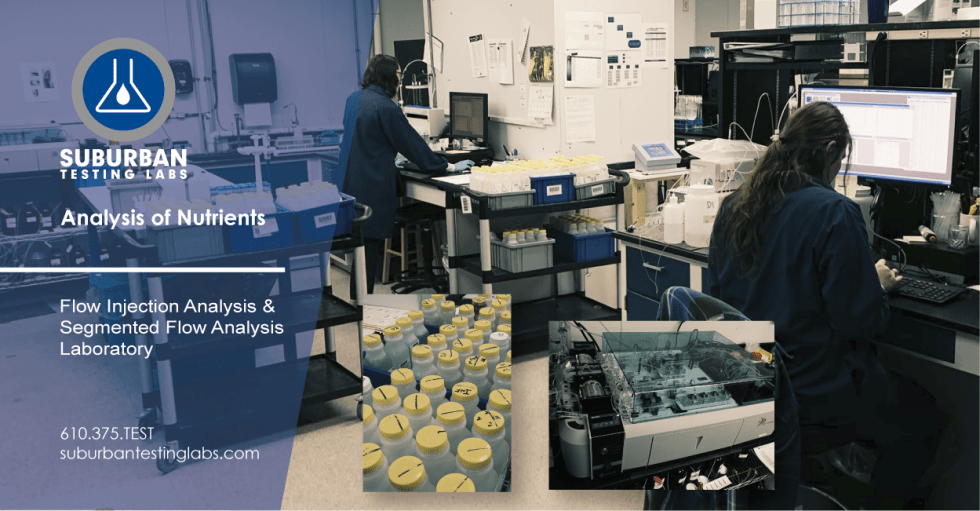Analysis of Nutrients in Waters
Total Phosphorous, Total Kjeldahl Nitrogen, Nitrate, and Nitrite are important nutrients for wastewater treatment plants to remove in their treatment processes. Excessive nutrients in our natural bodies of water stimulate algae and plant growth, create dissolved oxygen issues, and limits the ability of marine life to thrive. Before wastewater is discharged, operators are challenged with removing these nutrients during the treatment process to protect our rivers, lakes and streams.
Since the Chesapeake Bay Program began to take shape in 2010, many wastewater treatment plants invested in new technologies to achieve nutrient removal requirements. At the same time new testing requirements and limits began to appear on NPDES permits, and now we are seeing low level compliance requirements statewide.
When samples are collected, how do we test for them? We wanted to share one important part of our Inorganic Chemistry Department that our clients rely on for the analysis and reporting of nutrient concentration in their treated wastewater to ensure the preservation of our natural water environment.
Instrumentation
In the past 12 months our lab has processed over 37,000 samples for nutrient analysis. Our chemists and lab analyst utilize Flow Injection Analysis (FIA) and Segmented Flow Analysis (SFA) to process these samples. Our number one goal is always high quality, defensible data. But these instruments also have the advantage of delivering results to our clients faster, enabling them to make important treatment decisions.
Flow Injection Analysis (FIA)
Our FIAs are powerful automated chemistry analyzers used for performing analysis on TKN, Nitrate/Nitrite (Combined), and Cyanide (Total and Free). The continuous flow of samples through the instrument allow us to meet high demand and sample throughput with incredible accuracy. The instrument consists of an autosampler, a peristaltic pump, a power base module, and detector equipped to analyze.
Segmented Flow Analysis (SFA)
Our SFA system is primarily used for the analysis of Total Phosphorus, and has the capability to analyze Ammonia, and Nitrate/Nitrite Combined. The SFA instrumentation operates similarly to a FIA. Both Segmented Flow Analysis (SFA) and Flow Injection Analysis (FIA) are continuous flow methods that rapidly process large numbers of samples. SFA analysis also adds an inline digestion step which removes the need for separate digestion preparation, and improves opportunities for acceptable quality control, limiting the need for re-analysis.
SFA and FIA utilize the same basic operation including a peristaltic pump that continuously merges samples and reagents in exact proportions that are determined by the internal diameter of plastic pump tubing. The primary analytical difference between SFA and FIA is that SFA mixes by turbulence produced by the introduction of a segmentation gas (bubbles) and FIA relies on dispersion and generation of an asymmetric Gaussian shaped color gradient with a detector response being proportional to concentration.1
As noted above, both FIA and SFA provide the Nitrate/Nitrite Combined result. For quantitative results of the individual constituents, our chemists utilize Ion Chromatography, a different technology and method altogether.
Analysis
Our team of analysts work nearly around the clock processing samples from multiple states in the mid-Atlantic region. Our goal is to get our clients data fast, and so it takes a lot of coordination, communication, and collaboration from our team to make that happen.
While speed is important, high quality, defensible data always comes first. After our analysts prepare, analyze, and enter results for these samples, our team of Quality Specialists validate the results and quality control associated with each batch of analysis.
Following validation by our Quality Team, our Clients Services Team then reviews the data again, following a specific checklist of criteria before the results can be released to the client. Once approved, our client receives the report.
Our mission is to provide high quality, defensible lab testing data from all our various departments to our clients that is needed for decision making in order to protect the health of the environment, and the public. While this happens in many departments, the Gravimetric Lab is essential to the success of our overall company mission, and for the decision making of our clientele.
To speak to a Suburban Testing Labs representative about our testing services or to learn more about our technical resources, contact us anytime.
1 – Source: https://www.ezkem.com/faq-items/sfa-fia/

